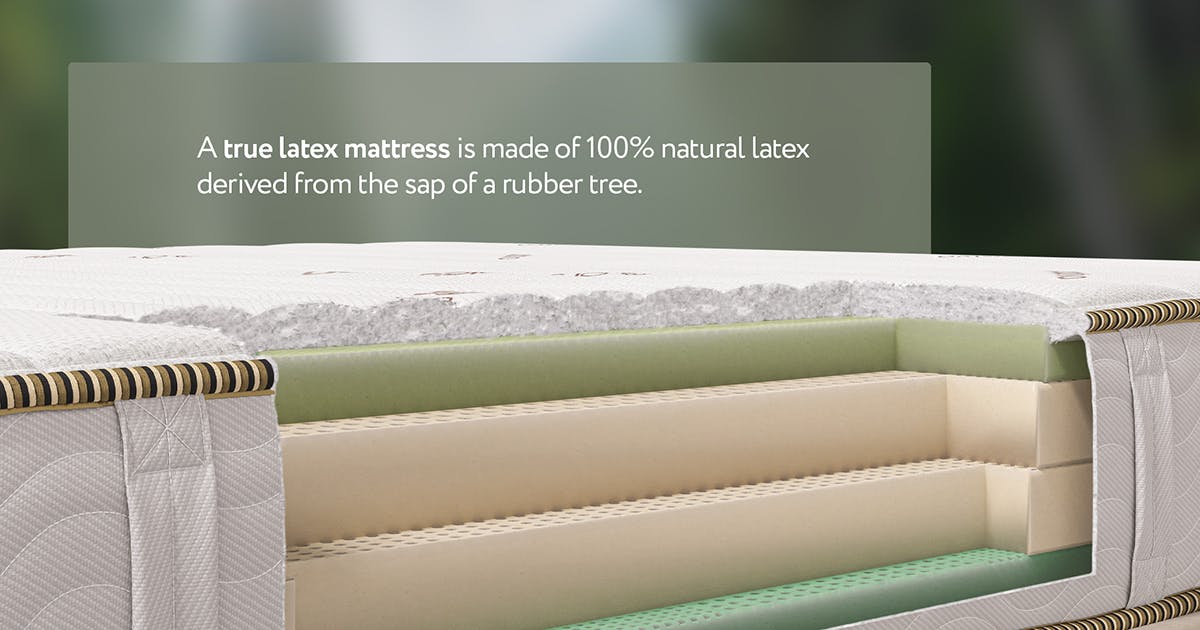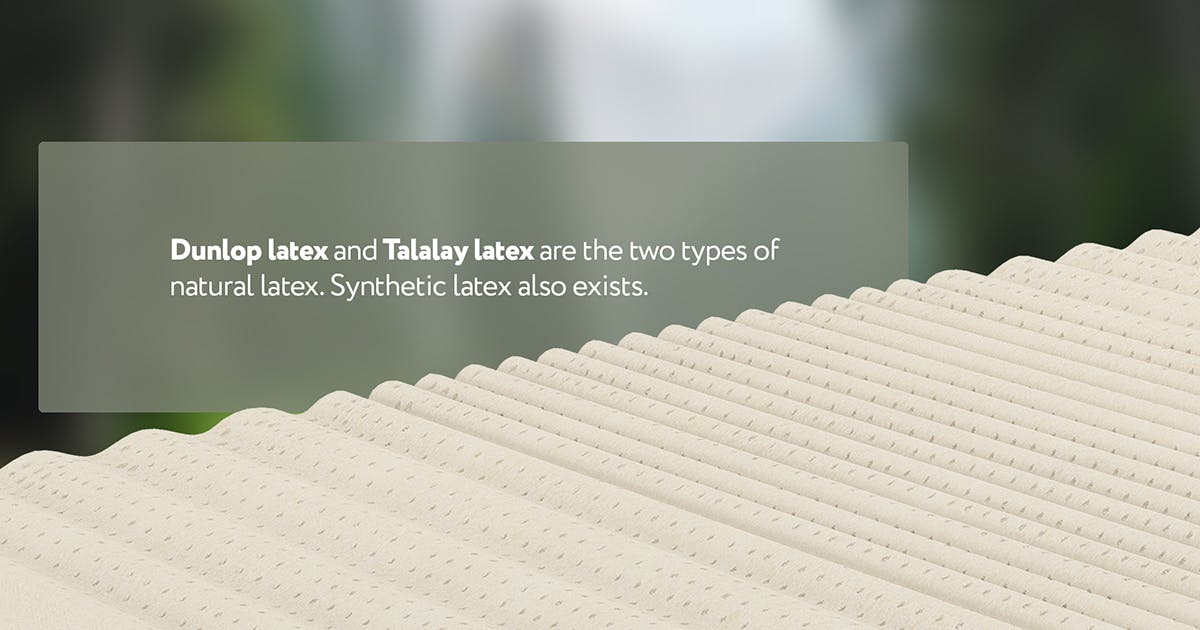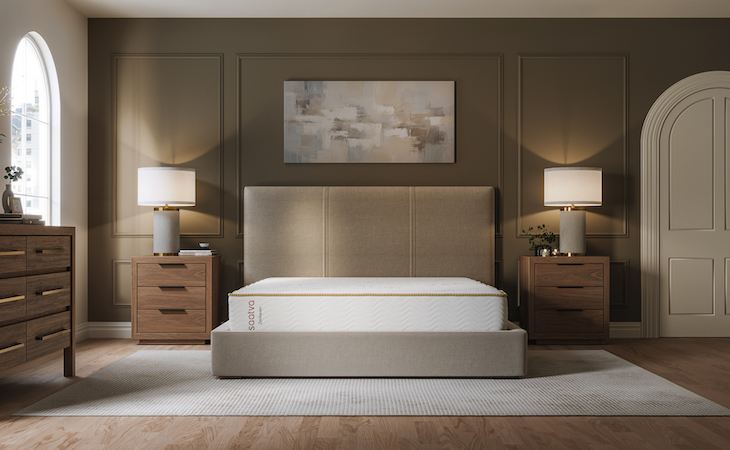Latex mattresses have been around for a while but have only recently started gaining popularity. They’re naturally soft, resilient, and breathable, which makes for a cool and comfortable night’s sleep.
If you’re in the market for a new mattress, we’ve compiled a guide to determine whether or not a latex mattress is right for you.
What is a latex mattress?
A true latex mattress is made of 100% natural latex derived from the sap of a rubber tree. This makes it hypoallergenic and gives it a soft and plush feel. It’s commonly designed for pressure relief and comfort for all types of sleepers.

Most latex mattresses aren’t made from a single block of foam. Instead, they’re formed from several latex layers of varying thickness and density. The denser layers of latex make them long-lasting and durable over time.
What is inside of a latex mattress?
Latex mattresses have pretty simple construction. The bottom layer is the support core, while the top layer is engineered for comfort. (The flippable

Our dual-sided organic natural latex mattress for buoyant, pressure-relieving comfort
mattress actually has the support core in the middle, surrounded by comfort layers on either side.)
A latex mattress will also include other materials, such as organic cotton or natural wool, commonly used as a flame retardant, in the padding and cover.
There are also quite a few different types of latex mattresses on the market. To ensure you’re getting the perfect latex mattress for your sleeping needs, you’ll need to know the key differences between the different types of latex.
Different types of latex
There are two methods of producing natural latex, and each one results in a mattress with a very different feel. There’s also synthetic latex, which differs from the natural kind.
- Dunlop latex: This is the original natural latex production process that began in the 1930s. It involves stirring, molding, and baking the tree sap.
- Talalay latex: This is the second iteration of natural latex foam. Talalay latex requires the foam to be poured in a vacuum-sealed chamber. After being vacuum sealed, the latex is flash-frozen to stabilize the particles before being baked into a solid form.
- Synthetic latex: This is the least expensive latex option on the market because it’s not natural. Synthetic latex is traditionally made with polyurethane and leads to a similar comfort level as natural latex.

Synthetic vs. natural latex
Not all beds marketed as latex start out as tree sap. You can also find synthetic latex mattresses or ones featuring a blend of natural and synthetic material.
Synthetic latex materials are typically made out of polyurethane foam. This material feels very similar to natural latex, but it’s not eco-friendly. The petroleum based-ingredients in synthetic latex may release toxic chemicals into the air, which is known as off-gassing.
While synthetic latex mattresses cost less than organic latex mattresses, they’re definitely not as durable. And while natural latex is free of potential chemical irritants that could aggravate allergies or sensitivities, the same isn’t true of synthetic latex. (Learn more about common mattress chemicals and how to avoid them.)
A natural latex mattress will have a higher latex foam density. Generally, mattresses with a higher foam density are considered to be of better quality. Synthetic latex mattresses don’t have a very high density, which makes them considerably less durable.
The benefits of latex mattresses
Here are some of the biggest benefits of sleeping on a latex mattress:
- Latex mattresses are conforming yet buoyant. A latex mattress offers the best of both worlds: It will conform to your body like memory foam, but it’s responsive and bouncy like innerspring. A latex mattress tends to contour to the curves of a sleeper rather than just sink beneath their weight like some memory foam mattresses have a tendency to do. Because of this, latex mattresses can help relieve back pain. Latex mattresses also have excellent motion isolation, preventing any disruptions by your sleep partner.
- Latex mattresses are good for allergy sufferers. Natural latex is hypoallergenic and resistant to mold and dust mites. That means an all-latex mattress is a good choice for anyone with allergies.
- Latex mattresses are eco-friendly. Natural latex foam, which comes from the sap of the rubber tree, is a greener alternative to conventional foams. It’s sustainable, nontoxic, and biodegradable.
- Latex mattresses sleep cool. Because latex foam has a more open cell structure than other types of foam, it allows for much better airflow through the bed and a cooler night’s sleep. This is great for people with larger body types or people who give off a lot of body heat at night.
- Latex mattresses last a very long time. Natural latex is extremely durable. For that reason, latex mattresses have a longer average lifespan than other types of beds. Latex mattresses can last for 15 years or more. (Learn more about the average latex mattress lifespan.)

The drawbacks of latex mattresses
There are pros and cons to every type of mattress. A latex mattress may not be right for you if:
- You’re on a budget. Latex mattresses are among the most expensive due to the cost of harvesting and processing the material. (Synthetic latex mattresses are cheaper than natural latex beds, but remember: They’re not as durable or eco-friendly.)
- You don’t want to deal with a heavy mattress. On average, latex mattresses are heavier than other types of mattresses. So if you think you’ll be moving in the future, know that moving a latex mattress will likely require more effort than moving another type of bed would. (Here are expert tips for moving a mattress.)
Latex mattresses and sleeping positions
Latex mattresses suit a wide range of sleep styles, but they’re especially a good pick for side sleepers. This is because the latex tends to conform to your body and cushion the pressure points associated with sleeping on your side as opposed to your back or stomach.
You can still find your latex mattress match if you sleep on your back or stomach. Within the latex mattress category, look for these features depending on your preferred sleep position:
- If you’re a side sleeper: Steer clear of a latex mattress with a high firmness level, which can cut off blood flow and cause numbness and tingling. Choose a softer comfort level in a latex mattress.
- If you’re a back sleeper: Opt for a latex mattress that is medium-firm. Anything too soft won’t give you enough support, while anything too firm or springy may cause back pain.
- If you’re a stomach sleeper: A medium to slightly firmer latex mattress will support your body in neutral alignment and help with back and neck pain relief.
Latex vs. other types of mattresses
Let’s take a look at how latex mattresses compare to other types of mattresses.
Type of Mattress Price Lifespan Best Sleeping Position Allergens Firmness Levels Latex $1,300- $3,000 15+ years Any Hypoallergenic Medium to firm Memory Foam $800- $2,500 8-10 years Side and back Hypoallergenic Soft to medium-firm Hybrid $500 – $2,700 8-10 years Side and back Only some are hypoallergenic Medium-firm to firm Innerspring $500- $1,800 6-8 years Any Only some are hypoallergenic Soft to firm
Frequently asked questions about latex mattresses
Purchasing a latex mattress can be overwhelming. No worries—we’re here for you. In this FAQ section, we answer your most pressing questions about latex mattresses.
How long do latex mattresses last?
While other mattress types tend to last about 7-10 years on average, natural latex mattresses typically have a lifespan of at least 15 years.
They’ll last longer than mattresses made of manmade material, like synthetic latex or memory foam. The reason they last longer than other mattress types is the inherent durability of the material.
Related: Difference between latex and memory foam mattresses
Which type of latex foam is better: Talalay or Dunlop?
Both Talalay and Dunlop latex foam mattresses offer excellent breathable, durable, and supportive sleeping surfaces. Still, there are some minor differences between the two.
While Talalay latex mattresses offer great temperature control and responsiveness, Dunlop latex is a bit denser and may sleep slightly warmer. However, manufacturers have ways of aerating Dunlop to improve air circulation.
Generally, Dunlop is slightly firmer than Talalay, but firmness levels vary greatly depending on the mattress manufacturer.
Dunlop is slightly more durable than Talalay and also costs slightly less because the production process is less labor-intensive. Because it’s slightly less energy-intensive to produce, Dunlop might be somewhat more sustainable than Talalay.
Can you flip a latex mattress?
The answer depends on the brand of latex mattress you decide on buying.
Most latex mattress brands offer distinguishable tops and bottom layers that aren’t designed for flipping. Then there are flippable latex mattresses that provide different levels of feel and firmness.
Our

Our dual-sided organic natural latex mattress for buoyant, pressure-relieving comfort
latex mattress is a long-lasting, durable mattress that’s designed to be flippable. It delivers a different level of firmness on each side. One side provides a plush feel, while the other is 18% firmer for sleepers who desire added support.
Check out Saatva’s latex mattress options
When it comes to buying a latex mattress, you have a lot of options. It’s important to choose a high-quality mattress that will support you for years to come.
Saatva offers a variety of latex mattresses to suit your sleep needs. Our

Our hand-tufted, organic natural latex hybrid innerspring for buoyant, cooling comfort
is handcrafted with organic and natural materials, including natural latex, organic cotton, and New Zealand wool, for the ultimate in cool, comfortable sleep.
Enjoy the feel of a classic innerspring mattress with the added responsiveness of latex.
All of our mattresses come with a lifetime warranty, along with a 365-night sleep trial so you can try one at home before deciding if it’s right for you.




